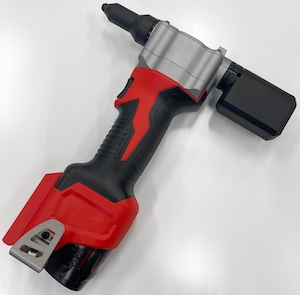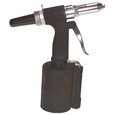Electric Rivet Gun

Figure 1: Electric rivet gun
An electric rivet gun is a battery-powered tool that installs a rivet. Various applications like automotive, construction, and DIY home projects use an electric rivet gun when portability and efficiency are essential. This article explores the design of an electric rivet gun, how to use the tool, and its comparison with other rivet gun types.
Table of contents
- Rivets and rivet guns
- Electric rivet gun parts
- How to use an electric rivet gun
- Precautions
- Electric rivet gun vs manual rivet gun
- Electric rivet gun vs pneumatic rivet gun
- FAQs
View our online selection of pneumatic rivet guns!
Rivets and rivet guns
A rivet is a popular mechanical fastener to join two or more materials. Rivets are used to join large structural pieces and small electronic assemblies. A rivet consists of a head at one end, and a cylindrical body at the other end called its shaft. The shafts are hollow with another internal piece called the mandrel.
Rivet guns are the tools used to install a rivet. An electric rivet gun is portable, easy to use, and highly versatile. There are also other rivet gun types like manual and pneumatic. Manual rivet guns use a simple lever and squeeze technique. Pneumatic rivet guns use compressed air to install a rivet. This article concentrates on installing a blind (pop) rivet using a battery-operated rivet gun. Read our article on rivets for an in-depth analysis of the various rivet types.
Electric rivet gun parts
Battery-powered rivet guns are versatile cordless tools. The user simply needs to push a button to install a rivet. There are two main types of electric rivet guns:
- Without a mandrel holder: The gun drops the mandrel out of the nose piece.
- With a mandrel holder: The gun pulls the mandrel into a mandrel holder (known as ‘catch’ or ‘capture cup’). The catch enables faster rivet installations, but the user needs to be careful not to overfill the catch to avoid jamming the gun. Also, rivet guns with a catch are more expensive than those without.
The other main parts of an electric rivet gun are:
- Nose piece: The nose piece holds the rivet’s mandrel during operation.
- Switch: Press the switch to operate the rivet gun.
- Battery cartridge: The battery cartridge contains the battery to power the motor within an electric rivet gun. Press the button in front of the cartridge to slide it into or out of the tool.
- Charging slot: Use this spot to charge the rivet tool battery.
How to use an electric rivet gun
- Place the pop rivet’s mandrel in the nose piece and position the tool appropriately.
- Pull and hold the switch until the rivet is fully set in the material.
- The tool will automatically return to its initial position if the user releases the switch before the rivet is fully set. Repeat step 2 if this happens.
- Release the switch if the pop rivet has set completely. The tool will return to its initial position automatically.
- The mandrel drops into the mandrel collector, or it drops out from the nose piece depending on the type of rivet gun. The working mechanism is the same for both kinds of electric rivet guns, except for the last stage: collecting the mandrels.
Precautions
- Always remove the battery pack from the tool before cleaning and maintenance.
- Empty the mandrel collector periodically depending on the size of the pop rivets used. The capacity of the mandrel holder varies inversely with the rivet size. The tool’s data sheet lists the values of nominal rivet diameters versus the mandrel capacity.
- Check the rivet gun’s motor regularly to ensure that it runs smoothly and that the temperature is within its operational range. A damaged motor will eventually break down and cause problems with the rivet gun.
Electric rivet gun vs manual rivet gun
Manual and battery-operated pop rivet guns accomplish the same riveting process. Consider the following factors while choosing an electric or manual rivet gun:
- Ease of use: Electric rivet guns are easy to operate and require less human effort than manual rivet guns. The user must activate the manual rivet gun’s handles multiple times, whereas the same mechanism occurs by pressing a switch on a battery-operated rivet gun.
- Cost: Electric rivet guns are expensive in comparison to their manual counterparts.
- Amount of riveting work: Choose a manual rivet gun when there is little riveting work to do. The electric gun is handy when the user intends to accomplish a large riveting task.
Electric rivet gun vs pneumatic rivet gun
A pneumatic rivet gun uses compressed air to drive and install blind rivets through two or more components, binding them together. The following discusses the pros and cons of pneumatic and electric rivet guns.
Electric rivet gun
Pros
- Lightweight: Electric rivet guns are lightweight and come with an ergonomic design. The tool is convenient to use for long periods.
- Portability: The cordless feature enables the tool to access applications that are hard to reach.
- Cost: Electric rivet guns are less costly than pneumatic rivet guns.
Cons
- Battery: The main disadvantage of an electric rivet gun relates to it's battery. Depending on the model and frequency of usage, the battery typically only lasts a few hours (verify in manual). Therefore, there is a risk of losing power before the riveting job is complete and it needs to be charged.
Pneumatic rivet gun
Pros
- Reliable: A pneumatic rivet gun can work continuously while connected to an air compressor. There is no risk of a battery running out. Calculate the amount of compressed air needed for a job before beginning to ensure it does not run out. The tool’s data sheet describes how much compressed air is needed for each use.
- Efficiency: A pneumatic rivet gun offers an accurate riveting solution and, like electric rivet guns, may come with a catch in the back to collect mandrels.
Cons
- Accessibility: The long hose connecting the pneumatic rivet gun to the air compressor makes it difficult to use in hard-to-reach applications.
- Cost: A pneumatic rivet gun requires a significant amount of monitoring and maintenance and is expensive compared to an electric rivet gun.
- Maintenance: Ensuring proper lubrication is essential for a pneumatic rivet gun’s operation. The tool needs examination before each use.
FAQs
What are the different types of rivet guns?
There are different types of rivet guns like manual, electric, and pneumatic.
How does an automatic rivet gun work?
The rivet gun pulls the mandrel when the rivet is inserted in a pre-drilled hole. This collapses the rivet body to form a strong and lasting joint that binds both materials together.
What is an electric rivet gun?
An electric gun consists of a rivet gun and a power source, usually an internal rechargeable battery or an external power cord. It is used to join two materials together.





